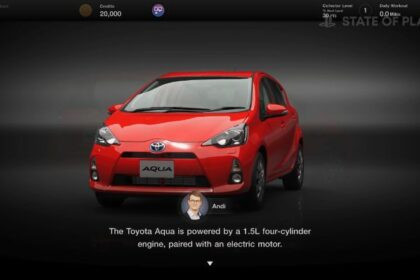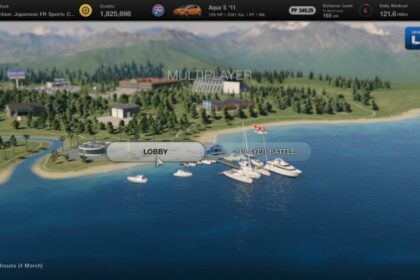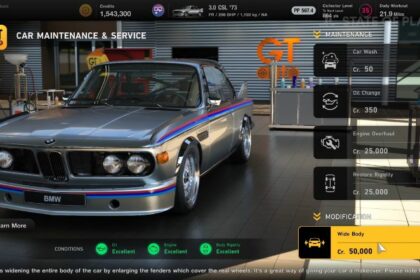With the return of license tests in Gran Turismo 7 comes the challenge of getting gold in them.
As per Gran Turismo tradition, getting gold in the license tests is a very tricky task. The good news is that getting gold throughout the B License is fairly easy when you know what you’re doing.
In this guide, we will be first looking at how you can get gold in all B License Tests in Gran Turismo 7 by scrutinizing each test, looking at areas you can improve on, and also checking out the various tools that the game has laid out in order to help you even further to ace these license tests.
A nice bonus from acing these tests is that you earn credits, but there are other ways of doing that as quickly as possible. Bookmark that link so you can get to it after this one.
General Tips on How to Be Faster
1. Assist Settings
Gran Turismo 7 hosts a bevy of driving assists that can help make a car easier to drive, but in turn, make it much slower. A general rule of thumb when going for these license tests is to turn off Active Stability Management (ASM) and Countersteering Assistance.
Both of these assists make your car a bit too neutered so it is a good idea to turn them off in order to be able to push the car to its limits and in turn, be faster.
Another assist worth turning down is Traction Control. Turning this off will help you in perfecting your throttle input, which is paramount to driving quicker. If you are having a hard time with exiting corners due to your wheels spinning too much, you can leave Traction Control to 1, just enough to keep the car tame as it gains grip.
ABS (Anti-Lock Braking System), however, should be left to Default as this helps you brake much better than if it was off as the car will be more prone to locking up its wheels without it.
The other assists like Driving Line Assistance, Brake Indicator, and Braking Area can be left on as these are non-intrusive to you and will only help you familiarize yourself with the track. When you get better and more familiar with driving, you can always turn these off for a more immersive experience.
Finally, we have Transmission. In general, we would want to have this on Manual in order for you to be able to shift gears yourself to accommodate the part of the track you are in, but it is completely understandable to also leave this on Automatic as the game does a pretty good job of shifting for you.
2. Watch the Demonstrations
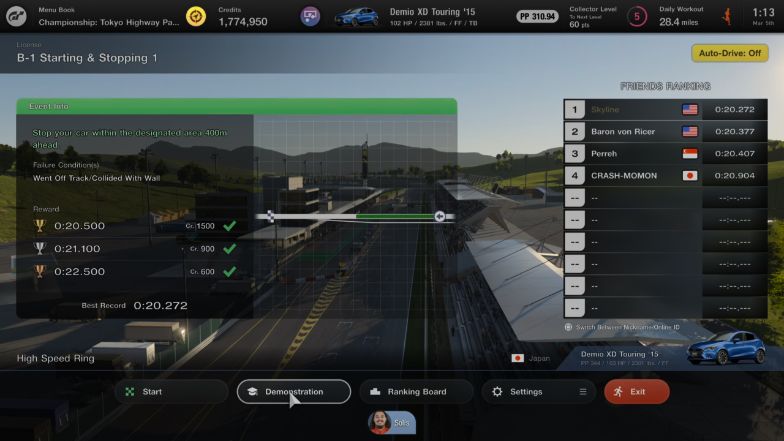
If you want to have a clue about what you need to do, you can always watch the demonstrations that are available on the Event Info screen. These demonstrations will show you a gold time and some of them will even have pauses in between the video in order to give you tips on what to do during the test itself.
However, they are not perfect as they do not really detail what happens when you are driving a car. They also do not give you the details of the car you are driving, whether it is FF, FR, or AWD.
They also show the “cleanest” racing line and not necessarily the fastest since there are some corners you can cut in order to shave a bit more time. This is where our guide comes in, giving you the little nuisances that can push you to do better. Maybe even beat the demonstration times themselves!
3. Ghost Settings

Even more supplementary assists in order to further your chances of getting a gold time in the license tests, you can display the ghost of the demonstration video in order for you to get to follow it.
You can also set the offset of the ghost so that you are essentially trailing and watching the ghost in real-time while trying to go for the gold time instead of trying to match or beat it.
The National B License Tests
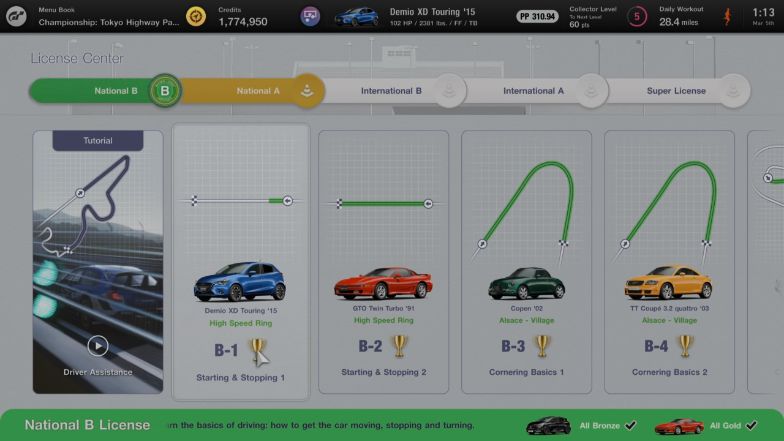
There are 10 National B License Tests and they are all fairly simple as these tests are meant to teach you the fundamentals of driving so some of the tests can be a bit mundane.
These tests use sections of High-Speed Ring, Alsace – Village, Trial Mountain Circuit, Mount Panorama Motor Racing Circuit, Dragon Trail – Seaside, and Tsukuba Circuit so familiarity with these tracks can help you ace these tests a lot quicker than normal.
B-1 Starting & Stopping 1

A very simple test. In this test, you will be driving the ’15 Mazda Demio XD Touring on the start / finish straight of High-Speed Ring. All you need to do is accelerate as quickly as possible and stop within the checkered box at the end of the straight.
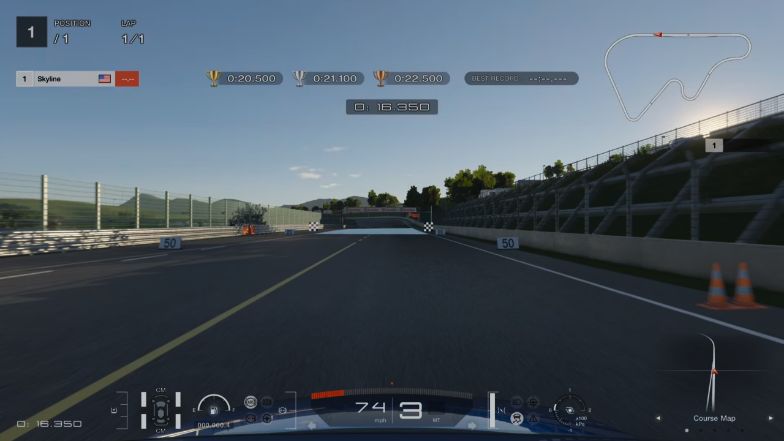
One of the tips given here is to find a landmark where you can brake. In this case, the landmark is some cones set aside on the right side of the track. Simply let go of the accelerator and fully step on the brakes once you have passed the cones in order to get gold on this test.
B-2 Starting & Stopping 2

Pretty much the same as B-1, the only difference is that B-2 puts you in a ’91 Mitsubishi GTO Twin Turbo, a much faster car than the Mazda Demio. This in turn makes your acceleration much quicker and your braking point come much sooner than in the Mazda Demio.
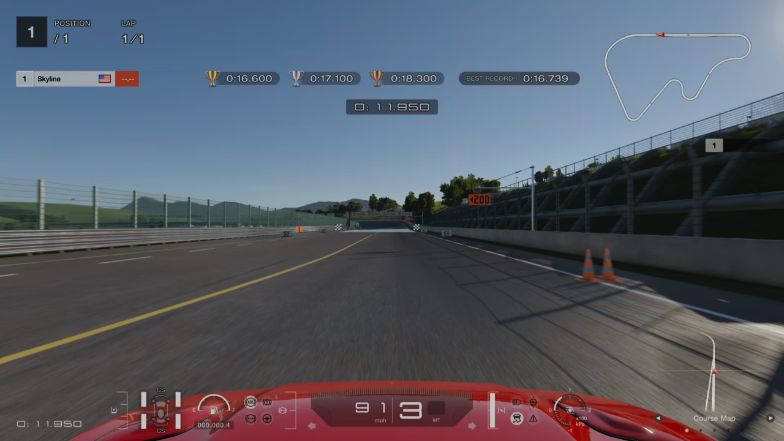
Luckily, cones are once again placed on the right side of the track to indicate where you should brake. Simply do what you did in B-1 when you have just passed the cones and you will get gold in this test in no time.
B-3 Cornering Basics 1

In this test, you will be driving the ’02 Daihatsu Copen Active Top, a FF (front-engined, front-wheel drive) car around a corner in the Alsace – Village circuit. This section of the track starts off downhill but slowly goes uphill on the corner.
Since your car is FF, in order to have it corner a bit better, you must lift off the throttle during the corner so that the front wheels can turn more efficiently. Only do this very quickly as this corner is fairly wide enough for the car to keep speed through it.
Also, try to catch as much curb as you can when going into the corner as it shortens the line towards the finish.
B-4 Cornering Basics 2

Pretty much the same as B-3, the difference here is that you are driving the ’03 Audi TT Coupe 3.2 Quattro, an AWD (all-wheel drive) car with a lot more power than the Daihatsu Copen.
AWD cars in general also suffer from understeer like FF cars, but they are also a bit prone to oversteering if too much throttle is applied.
For this test, you will need to take a bit of a wider line into the turn, brake a bit to reduce your speed, and then turn into the corner while you are off the throttle. Once you have gone past the apex of the turn, gun the throttle until the finish.
This is one of the trickier tests in National B so just practice and you will eventually get the gold!
B-5 Cornering Basics 3
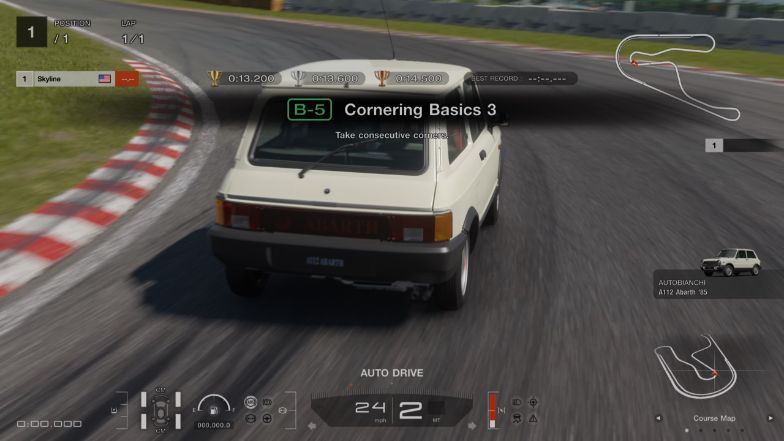
In this test, you will be driving the ’85 Autobianchi A112 Abarth, another low-powered FF car, on the second sector of Tsukuba Circuit which navigates two corners.
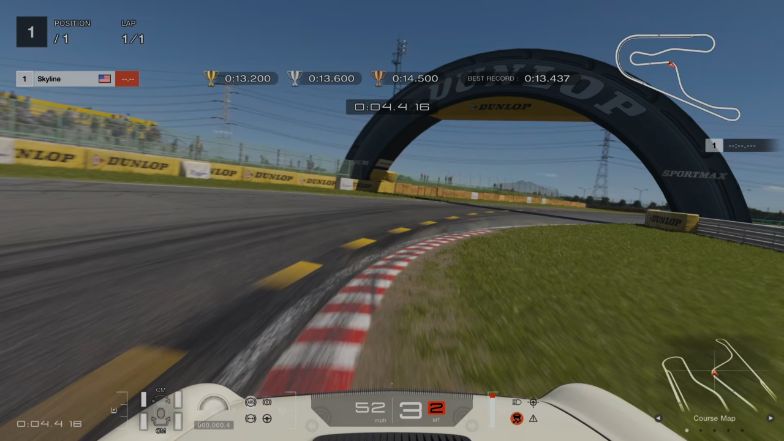
In the first corner of this sequence of corners, you can cut the track a bit to gain some extra time. Lift off the throttle if necessary in order to keep yourself from going too wide and in order to set yourself up for the sweeping second left-hand corner. The second corner can pretty much be taken flat out by this car.
The speed you are taking from the first corner will determine how quickly you will go through the second corner. This determines whether you will be getting gold so practice that first corner!
B-6 Cornering Basics 4
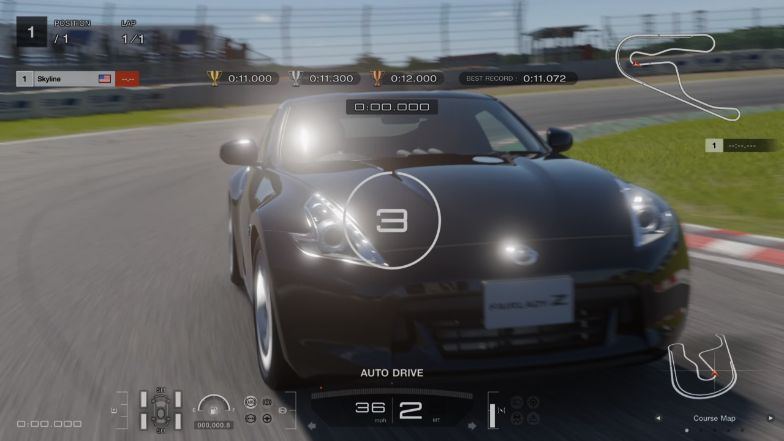
The same test as B-5, but this time you will be driving the ’08 Nissan Fairlady Z (Z34) which is a pretty fast FR (front-engined, rear-wheel drive) car.
The fundamentals of this test are the same as the B-5, except now you will be more inclined to keep your throttle in check as going full throttle with the Nissan Fairlady Z will have you end up spinning out.
For the first corner, try to take it wider than you would the Autobianchi A112 to set yourself up for the second corner. You can brake a bit if you think you entered the corner a bit too quickly, but keep your foot off the throttle until you have straightened yourself out for the second corner.
Once you are on the second corner, feather the throttle in order to keep the car in check, only pressing it further if you think there is enough grip on the rear tires and if the track is straight enough for you to do so.
This test is definitely up there in difficulty so keep practicing and you will eventually get gold here!
B-7 Cornering Basics 5
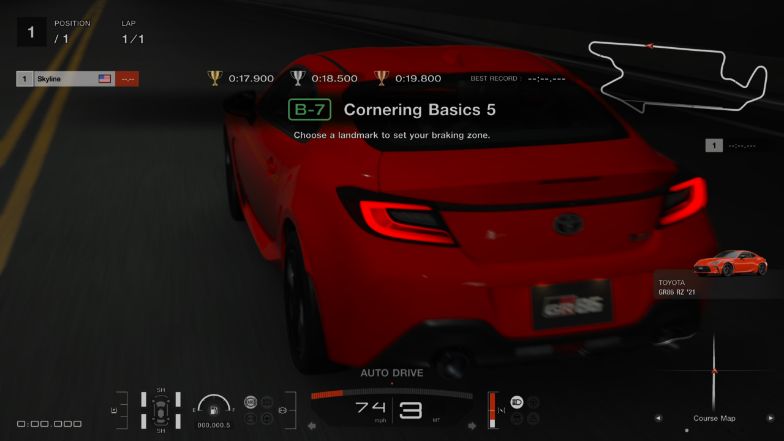
In this test, you will be taking a left-hand corner in a section of the Trial Mountain Circuit with the ’21 Toyota GR86 RZ, an FR car with a moderate amount of power.
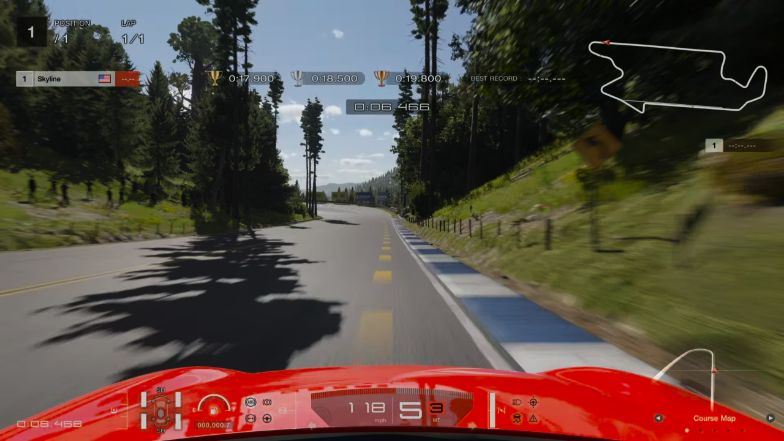
Your braking zone will determine whether you can gold this test or not. For me, I used the tree after the traffic sign on the right side as my braking marker. Simply brake as hard as you can and then turn to the left.
Once you are in the corner, keep off the throttle while turning left and go full throttle once the track straightens up. The car is a bit low on power so even though the car is FR, it will not wheelspin as much.
B-8 Cornering Basics 6

A rather similar test to B-7, only this time you will be taking the first (left-hand) corner of the famous Mount Panorama Motor Racing Circuit in the ’96 Mitsubishi Lancer Evolution IV GSR, a moderately-powered AWD car.

The fundamentals of this test are very similar to B-7 in that you will need to find a braking point in order to make the corner. In this case, I braked at around 75-80m from the corner, referencing the boards on the right.
Since there is no 80m board, I simply used the 100m and 50m board to estimate where 80m is. In this case, it is nearer to the 100m board and farther from the 50m board.
As with most cornering tests, keep your foot off the throttle until you have passed the apex of the turn and proceed to floor it once the track straightens out.
B-9 Cornering Basics 7

In this test, you will be racing around a double right-hander on the Dragon Trail – Seaside track using the ’20 Honda Civic Type R Limited Edition (FK8), a fast FF car.
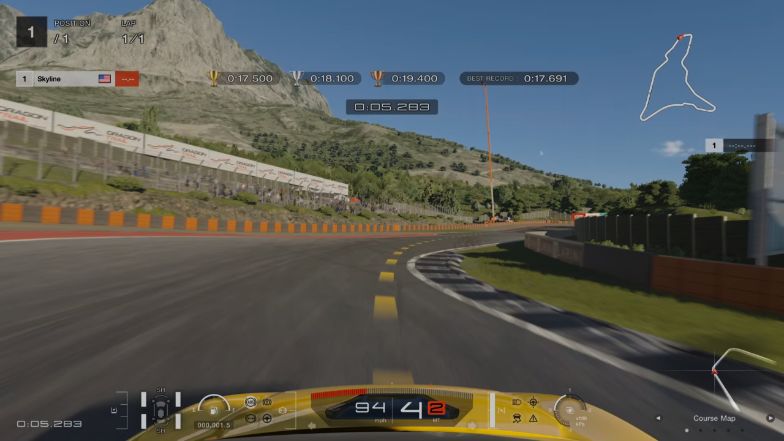
The first corner of this test is flat out, so simply stay on the throttle and turn to the right as hard as you can. Do not be afraid to get on the curbs on the corner exit as this still counts as being within the track’s limits.

The braking point for the next corner will be in the middle of the grassy patch on your left side. Brake and then turn to the right, trying to catch the curb there as well. With this being an FF car, the moment you put any amount of throttle, the car will start to straighten out, so be sure you have more than enough room on the corner exit before stepping on the throttle.
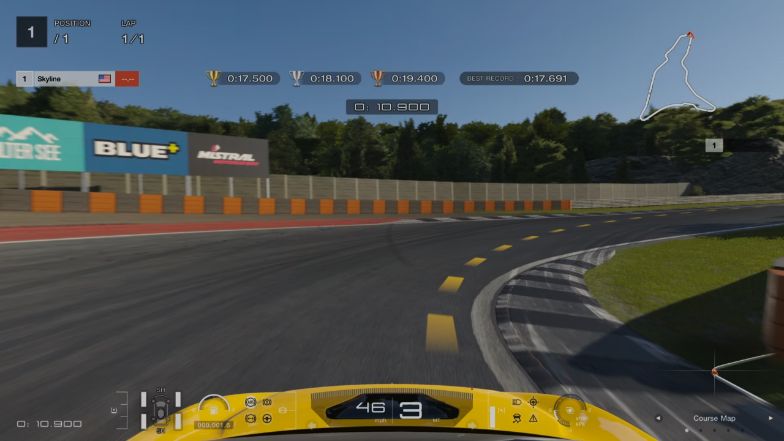
As with the corner exit of the first corner, the second corner exit also features a wide curb, so again, do not be afraid to get on those curbs and use as much track as you need as that still counts as being within track limits.
B-10 Driving Basics
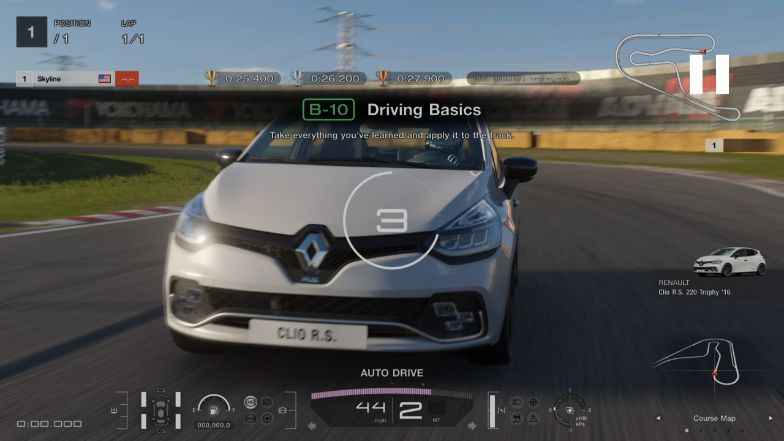
The final test of the National B License, this test will have you driving the ’16 Renault Clio R.S. 220 Trophy, a fast FF car, in Tsukuba Circuit once again, but this time integrating the exit from the first corner and the hairpin turn going into sector 2.
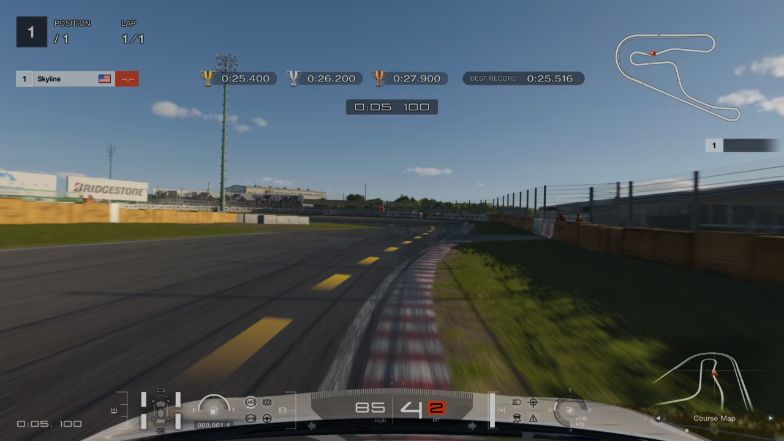
You will start this test off by navigating a fast left-right section leading onto the hairpin. This section is a bit tricky as you will effectively still be moving while braking, which is something you should not be doing as it will cause the front wheels to lock up.
The braking point for this is right before the track starts to straighten out before the hairpin. Brake hard and turn left hard to make the hairpin. Again, with this being an FF car, only apply throttle once you know the track straightens out.
The next section is pretty much the same as the section in both B-5 and B-6 so apply the same lessons you have learned there to this test.
The Prize for Getting Gold in All National B License Tests
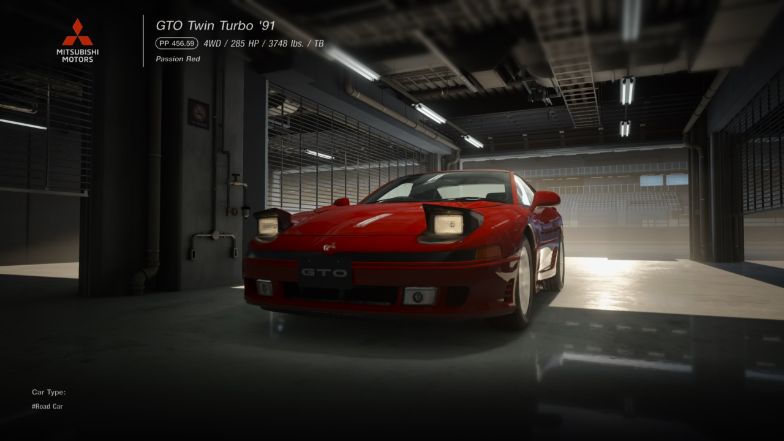
Aside from getting one step closer to the Hard Work Pays Off trophy, you will also get the ’91 Mitsubishi GTO Twin Turbo as your prize for getting all gold on the National B License Tests. This is the same car you used in the B-2 license test. Congratulations on getting gold on all National B License Tests!
Up next, it’s time to learn how to get gold in the A License Tests.
Final Thoughts
Although seemingly mundane to an experienced driver, the National B License Tests are a great stepping stone for beginners to learn about the characteristics of the different drivetrains of cars.
It also demonstrates how increasing a car’s power directly affects how it handles by doing 2 similar tests back-to-back, one with the low-powered car and one that is sportier.
Overall, the return of licenses to the Gran Turismo franchise is always a welcome sight as it is one of the things that just makes Gran Turismo unique from other racers.

